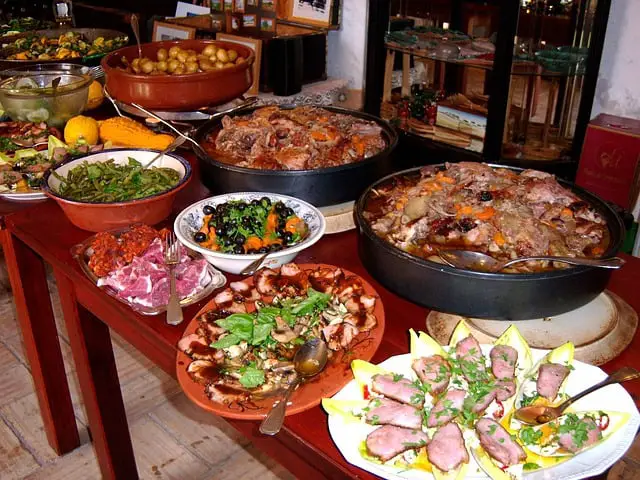Spices add flavor and aroma to our food, but have you ever wondered what it is that makes each spice unique? The science of flavor and aroma in spices can be complex, but in this blog post, we’ll explore the basics.
Flavor and aroma in spices come from a combination of volatile organic compounds (VOCs) and non-volatile compounds. VOCs are responsible for the aroma of a spice, while non-volatile compounds contribute to its flavor.
Some spices have more of the former and some have the latter. Let’s take a closer look at this topic so you can figure out how to easily – and often with health benefits – add taste and aroma (and color!) to your foods.
Fragrant spices have a high level of VOCs
The most fragrant spices are those with a high concentration of VOCs, such as cinnamon, clove, and vanilla. Cinnamon, for example, contains cinnamaldehyde, which is responsible for its warm, sweet aroma.
Clove contains eugenol, which gives it its strong, spicy aroma. Vanilla, on the other hand, contains vanillin, which gives it its sweet, floral aroma.
Here are ten of the most fragrant spices known for their strong smell:
- Cinnamon
- Cloves
- Vanilla
- Nutmeg
- Rosemary
- Sage
- Lavender
- Coriander
- Fennel
- Star Anise
These are spices that have a strong aroma and can add a nice scent to your foods which also translates into a more pleasant-tasting dish, too.
Strong tasting spices have a low level of VOCs
The strongest tasting spices are those with high levels of non-volatile compounds. For example, black pepper and ginger both have high levels of non-volatile compounds that contribute to their strong, pungent flavors.
Black pepper contains piperine, while ginger contains gingerols and shogaols, which give it its spicy, warming flavor.
Here are ten of the strongest tasting spices known for their flavor profile:
- Black Pepper
- Ginger
- Garlic
- Horseradish
- Mustard
- Wasabi
- Cayenne Pepper
- Turmeric
- Cloves
- Cardamom
You’ll see a few spicy spices on this list and ones that in general, are known for packing a powerful punch that your tastebuds might appreciate. Just be careful to not add too much as it can be overpowering for some.
Other factors that impact flavor and aroma of spices
In addition to VOCs and non-volatile compounds, the flavor and aroma of spices can also be influenced by factors such as the time of harvest, the method of processing, and even the type of soil in which the spice was grown.
So the next time you’re cooking with spices, think about the complex science behind their flavors and aromas. Whether it’s the sweet, floral aroma of vanilla, or the strong, pungent flavor of black pepper, each spice has its own unique profile that makes it a valuable addition to any kitchen.
Limiting the impact of strong spices
If you’re looking to limit the impact of strong tasting spices in your food dishes, here are some tips that may help:
- Start with a small amount: When adding strong spices, it’s best to start with a small amount and gradually increase to your desired level. This will prevent overpowering the other flavors in the dish.
- Balance with other ingredients: Balancing strong spices with other ingredients, such as sweeteners or milder spices, can help to tone down their impact.
- Cook spices with other ingredients: Cooking strong spices with other ingredients, such as vegetables or meats, can help to distribute their flavor and aroma more evenly throughout the dish.
- Use spices that complement each other: Using spices that complement each other, such as cumin and coriander, can help to balance out their flavors and aromas.
- Use fresh spices: Fresh spices have a more intense flavor and aroma than dried spices. If you’re looking to limit the impact of strong spices, consider using dried spices instead.
- Store spices properly: Strong spices can lose their flavor and aroma over time if they are not stored properly. To ensure that your spices are as fresh as possible, store them in airtight containers away from light and heat.
- Choose the right cooking method: Different cooking methods, such as roasting or sautéing, can bring out different flavors and aromas in spices. Consider the flavor profile you’re looking to achieve and choose the cooking method that’s best suited to your needs.
By following these tips, you can limit the impact of strong tasting spices in your food dishes and achieve a more balanced flavor profile.
Final thoughts
Strong tasting and smelling spices can add flavor and aroma to various food and drinks. Having said that, spices can often be overpowering if used in excess. So it’s important to test out what works for you and avoid using too many spices in your dishes. With strong-spices, a little often goes a long way.
Regarding the issue of Volatile Organic Compounds (VOCs): It’s important to note that you will come across this issue when it comes to other things in life such as paints, varnishes, and many coatings that you use around your home as well furniture and flooring among other things that also contain them. These can be harmful to your health due to the high level of VOCs that they contain.
When it comes to cooking, many cooking oils and other foods do release VOCs so using your kitchen fan to remove these fumes from your home is a good idea to be safe.
The truth is that VOCs are everywhere in life and it’s important to be aware of them and how to avoid the dangerous ones when possible.

